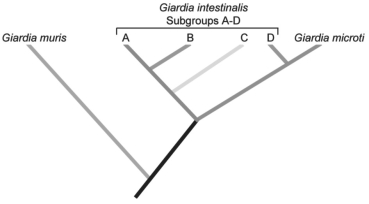Figure 29.1
Use the following information to answer the corresponding question(s) .
Giardia intestinalis can cause disease in several different mammalian species,including humans.Giardia organisms (G.intestinalis) that infect humans are similar morphologically to those that infect other mammals;thus they have been considered a single species,though other species in the Giardia genus infect other organisms.However,G.intestinalis has been divided into different subgroups based on their host and a few other characteristics.
In 1999,a DNA sequence comparison study tested the hypothesis that these subgroups actually constitute different species.The following phylogenetic tree was constructed from the sequence comparison of rRNA from several subgroups of G.intestinalis and a few other morphologically distinct species of Giardia.The researchers concluded that the subgroups of Giardia are sufficiently different from one another genetically that they could be considered different species.

-According to the phylogenetic tree in Figure 29.1,Giardia intestinalis constitutes a _____ group.
Definitions:
Q2: Refer to Figure 29.2 and consider the
Q2: What is an essential part of alternation
Q9: Which of the following structural features of
Q9: The function of the acrosomal complex during
Q26: How are RNA hairpin turns related to
Q27: Encouraging the growth (via nutrient fertilization)of photosynthetic
Q28: If a scientist needs to put new
Q33: How can an amino acid sequence be
Q49: Most moss gametophytes do not have a
Q61: You have discovered a previously unidentified plant,and